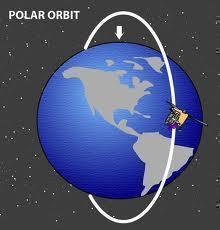Polar Orbit
A polar orbit is an orbit of any object in space, natural or synthetic, that passes around the Earth in a North-to-South direction rather than a West to East direction, which is known as an “equatorial orbit”. Polar orbits are advantageous because they will eventually travel across every possible latitudinal and longitudinal position on the Earth, allowing satellites that depend on a polar orbit to monitor the Earth much better than any other type of orbiting satellite.
How Polar Orbit Works
Polar-orbiting satellites are launched in the same way that equatorial satellites are, but instead of traveling in a West-to-East direction along with the Earth’s rotation, polar-orbiting satellites use powerful rockets to change their course and begin to travel in a North-to-South direction. As the Earth rotates West to East, the polar-orbiting satellite will eventually cross over every position on the Earth. In order to maintain its course, the polar-orbiting satellite must consistently boost itself back to an appropriate elevation and direction.
Applications
Polar orbits are used for monitoring the Earth for a variety of reasons. For example, meteorologists often depend on results from polar orbiting weather monitoring satellites to report weather conditions worldwide and predict future weather conditions. Likewise, polar orbits are often used for environmental reasons, such as measuring volcanic and seismic activity from space. Occasionally, polar orbits are also used for telecommunications, although this is rare.
Advantages
Polar orbits are advantageous because they allow a satellite to stay in the same path, yet travel across every possible latitudinal and longitudinal position on Earth. Although polar orbits must be maintained more than equatorial orbits, their benefits far outweigh their cost.



Comments - No Responses to “Polar Orbit”
Sorry but comments are closed at this time.